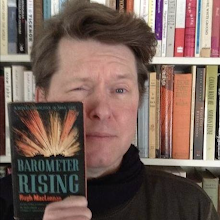It's my honour to present this guest post, a tribute to the late Crad Kilodney by his friend Ruth Bradley-St-Cyr. The photo of Crad comes courtesy of Lorette C. Luzajic.
Crad Kilodney and I became friends about 1980, the day he walked into the Kentucky Fried Chicken takeout where I worked, looked me square in the eye, and asked, “Do your chickens die in a state of grace?” To a geeky teenager with a quirky sense of humour, this was irresistible. “I certainly hope so,” I replied.
Crad lived in my North Toronto neighbourhood around Avenue Road and Wilson. After I moved to Hamilton, I had a dream about him and wrote to tell him about it. I dreamt that he had moved to a new basement apartment on the south side of Old Orchard Grove, about six houses down from Avenue Road. He wrote back and asked me to pick his lottery numbers for him, because he had just moved, exactly where I had said.
But Crad didn’t need the lottery. Lotteries are for poor people. Smart people invest in the stock market. So when Crad’s Long Island grandparents died and left him money, he invested in gold stocks and told me to do the same. Excellent advice. I wish I had had the money to invest, though I was leery of the social benefits of mining companies.
I have all of his books, mostly signed, up until 1992’s The Second Charnel House Anthology of Bad Poetry. A copy of his Worst Canadian Stories (volume 2, I think) was stolen in Nicaragua in 1988 and presumably is still in circulation there. His titles were always provocative, my favourites being Blood-Sucking Monkeys from North Tonawanda and Suburban Chicken-Strangling Stories. My favourite inscriptions are on The Green Book – “To Ruth, Avoid inhaling. Discontinue use if rash develops” – and on Human Secrets: Book Two – “To Ruth, Last copy of this book I will ever sell. Glad you got it.”
Yes, he was cranky. How could he not be? He sold his books not at fancy author signings with self-selected literary groupies, but on the streets of downtown Toronto, exposing himself day after day to the inanity of people who couldn’t even read his signs, never mind his books. “SLIMY DEGENERATE LITERATURE,” read one sign, and some illiterate soul asked if he was selling detergent. But Margaret Atwood talked to him whenever she saw him, and that was something of a balm to his wounded genius.
His best pokes at the literary establishment were two pranks, one of which I helped with. In the first prank, he took selected poems of Irving Layton, put a pseudonym on them, and submitted them to publishers. Nobody, except Layton’s own publisher, picked up on this; the other publishers rejected the work. The second prank, requiring the assistance of his friends, was to submit rather bad stories from great writers to the CBC literary competition. I got to be Maxim Gorky. All the stories were rejected but, again, without anyone identifying any of the real authors.
Kilodney’s style was brooding, raw, and spare. He always struck me as a man already in purgatory. But he was always happy to meet a kindred spirit, and he was not entirely solitary in his publishing endeavours. Besides his own Charnel House imprint, he also published with Black Moss Press, Coach House Press, The Canadian Fiction Magazine, The Carolina Quarterly, Descant, Lowlands Review, and others. Some of his correspondence can be found in The Canadian Fiction Magazine fonds (Box 16, file 131) at the McMaster University archives. But his own extensive papers (26 archival boxes/5 linear metres) he donated to the Thomas Fisher Rare Book Library at the University of Toronto.
Some of his letters – along with his “street tapes,” noir films on VHS, and a couple of vanity press books he had worked on, including one about a barber – is no doubt buried in one of my own bankers boxes of CanLit archives. Crad and I were always happy to run into each other – he kept box 281 at the Avenue Road post office – but I moved away from Toronto a dozen years ago and left him to his gold stocks. His real name wasn’t Crad. I think it was Lou, but I’m not sure now. He had beautiful hands. He claimed not to be a draft dodger. He has a sister somewhere who he never contacted. I’m sure she doesn’t acknowledge him either, but he was a wonderful, unforgettable, eccentric character and Toronto is poorer without him.
Ruth Bradley-St-Cyr
Embrun, Ontario





















